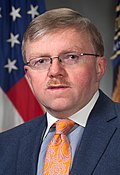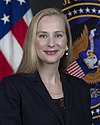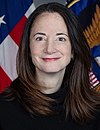Director of National Intelligence: Difference between revisions
Pat Palmer (talk | contribs) (removing PropDel, but subject to extensive revisions) |
Pat Palmer (talk | contribs) mNo edit summary |
||
| Line 1: | Line 1: | ||
{{subpages}} | {{subpages}} | ||
The '''Director of National Intelligence''' ('''DNI''') is | The '''Director of National Intelligence''' ('''DNI''') is appointed by the [[President of the United States of America]], per the Intelligence Reform and Terrorism Prevention Act of 2004, to lead the sixteen-member United States Intelligence Community (IC) via the Office of the Director of National Intelligence (ODNI). | ||
Congress specified that the Director and ''Principal Deputy'' Director cannot both be active-duty military officers and that one or the other should be a military intelligence officer, usually of four-star rank, or have extensive experience in military intelligence. {{UnitedStatesCode|50|403-3a}} | |||
== Office of the Director of National Intelligence (ODNI) == | == Office of the Director of National Intelligence (ODNI) == | ||
Revision as of 10:00, 21 April 2024
The Director of National Intelligence (DNI) is appointed by the President of the United States of America, per the Intelligence Reform and Terrorism Prevention Act of 2004, to lead the sixteen-member United States Intelligence Community (IC) via the Office of the Director of National Intelligence (ODNI).
Congress specified that the Director and Principal Deputy Director cannot both be active-duty military officers and that one or the other should be a military intelligence officer, usually of four-star rank, or have extensive experience in military intelligence. 50 U.S.C. § 403-3a
Office of the Director of National Intelligence (ODNI)
The Intelligence Reform and Terrorism Prevention Act of 2004 established the Office of the Director of National Intelligence (ODNI) as an independent agency to assist the DNI. The ODNI has about 1,500 employees. The National Counterterrorism Center is a major organization within the ODNI.
On March 23, 2007, DNI Mike McConnell announced organizational changes, which include:
- elevating acquisition to a new Deputy DNI position
- creating a new Deputy DNI for Policy, Plans, and Requirements (replacing the Deputy DNI for Requirements position)
- establishing an Executive Committee
- designating the Chief of Staff position as the new Director of the Intelligence Staff.
100 Day/500 Day Plans
The Office of the Director of National Intelligence has released Intelligence Community 100 Day & 500 Day Plans for Integration & Collaboration. These plans include a series of initiatives designed to build the foundation for increased cooperation and reform of the U.S. Intelligence Community.[7]
History
Prior to establishment of the DNI, the head of the United States Intelligence Community was the Director of Central Intelligence (DCI). The DCI concurrently served as the Director of the Central Intelligence Agency (CIA).
Establishment of the DNI position was one of the recommendations in the 9/11 Commission Report|report by the National Commission on Terrorist Attacks Upon the United States|9/11 Commission investigating the 9/11|September 11 attacks. The report, which was released on July 22, 2004, identified major intelligence failures that called into question how well the Intelligence Community protected US national and homeland security interests against attacks by foreign terrorists.
Soon thereafter Senators Dianne Feinstein, John D. Rockefeller IV and Bob Graham introduced legislation to create a Director of National Intelligence, S. 2645, introduced on June 19, 2002. Other, similar, legislation soon followed. After considerable debate on the scope of the DNI's powers and authorities, the United States Congress passed the Intelligence Reform and Terrorism Prevention Act of 2004 by votes of 336-75 in the U.S. House of Representatives|House of Representatives, and 89-2 in the United States Senate|Senate. President George W. Bush signed the bill into law on December 17, 2004. Among other things, the law established the DNI position as the designated leader of the United States Intelligence Community and prohibited the DNI from serving as the CIA Director or the head of any other Intelligence Community element at the same time. In addition, the law required the CIA Director to "report" his agency's activities to the DNI.
Critics say compromises during the bill's crafting led to the establishment of a DNI whose powers are too weak to adequately lead, manage and improve the performance of the US Intelligence Community.[8] In particular, the law left the United States Department of Defense in charge of the National Security Agency (NSA), the National Reconnaissance Office (NRO), and the National Geospatial-Intelligence Agency. (The limited DNI role in leading the US Intelligence Community is discussed in the United States Intelligence Community|Intelligence Community article.)
On February 17, 2005, President George W. Bush named U.S. Ambassador to Iraq John Negroponte to the post, pending United States Senate#Appointments|confirmation by the Senate. It was reported that President Bush's first choice for Director of National Intelligence was former Director of Central Intelligence Robert M. Gates, who was serving as president of Texas A&M University; however, Gates declined the offer.[9] Negroponte was confirmed by a Senate vote of 98 to 2 in favor of his appointment on April 21, 2005, and was sworn in by President Bush on that day.
On February 13, 2007, Negroponte was sworn in as Deputy Secretary of State, and John Michael McConnell became the 2nd Director of National Intelligence.
Directors of National Intelligence
| Name | image | start | end | President(s) served under | notes |
|---|---|---|---|---|---|
| John Negroponte | 
|
2005-04-21 | 2007-02-13 | George W. Bush | |
| John McConnell | 
|
2007-02-13 | 2009-01-28 | George W. Bush | |
| Dennis Blair | 
|
2009-01-27 | 2010-08-05 | Barack Obama | |
| David Gompert | 
|
2010-05-28 | 2010-08-05 | Barack Obama | Acting |
| James Clapper | 
|
2010-08-05 | 2017-01-20 | Barack Obama | |
| Michael Dempsey | 
|
2017-01-20 | 2017-03-16 | Donald Trump | |
| Dan Coats | 
|
2017-03-16 | 2019-08-15 | Donald Trump | |
| Joseph Maguire | 
|
2019-08-15 | 2020-02-20 | Donald Trump | Acting |
| Richard Grenell | 
|
2020-02-20 | 2020-05-26 | Donald Trump | Acting |
| John Ratcliffe | 
|
2020-05-26 | 2021-01-20 | Donald Trump | |
| Lora Shiao | 
|
2021-01-20 | 2021-01-21 | Joe Biden | Acting |
| Avril Haines | 
|
2021-01-21 | present | Joe Biden |
References
- ↑ 07-0224 DNIHandbook.indd
- ↑ 07-0224 DNIHandbook.indd
- ↑ Pincus, Walter. An Admonition on Intelligence, The Washington Post, 2007-02-26. Retrieved on 2007-03-24.
- ↑ Negroponte, John (2006-05-08). Office of the Director of National Intelligence, Intelligence Community Policy Memorandum Number 2006-200-2 (PDF). Retrieved on 2007-03-24.
- ↑ ODNI Announces Senior Leadership Positions, ODNI News Release No. 5-05 (2005-10-31). Retrieved on 2007-03-24.
- ↑ Negroponte, John (2005-11-09). Office of the Director of National Intelligence, Intelligence Community Policy Memorandum Number 2005-200-1 (PDF). Retrieved on 2007-03-24.
- ↑ http://www.dni.gov/press_releases/20070913_release.pdf
- ↑ Kaplan, Fred. You Call That a Reform Bill?, Slate Magazine, 7 December 2004.
- ↑ CNN.com (2005) Bush names Negroponte intelligence chief. Retrieved May 14, 2006.